#Driscoll Model of Reflection
Text
Although there is no one choice that suits all when it comes to the model of reflections largely due to the diverse personalities of the people across yet Driscoll’s model of reflection is one of the most preferred due to its sheer simplicity.
0 notes
Text
Learning Reflective Evaluation
This blog post will be my learning reflective evaluation, where I identify and reflectively evaluate my new learning over the project.
As I reach the conclusion of my major study project, it is imperative to reflect on the learning journey that has shaped my final artefact. Using Gibbs’ Reflective Cycle (1988) as a framework, I will critically evaluate the process, outcomes, and personal growth throughout this project, grounded in external criteria such as audience expectations, professional standards, and the purpose of the artefact.
Description
The project began with an ambitious goal: to create a comprehensive artbook supporting a video game prototype that would showcase my skills as a concept artist, blending 2D and 3D techniques with emerging technologies like AI-driven tools. The artefact was intended to serve two primary audiences: industry professionals, as a portfolio piece, and potential investors or collaborators interested in the game concept. The initial vision was clear, but as the project progressed, challenges emerged, leading to outcomes that, while educational, did not fully meet my personal expectations.
Feelings
Reflecting on the experience, I am torn between satisfaction and a sense of missed potential. On one hand, the learning curve was steep, and the skills I acquired - particularly with new tools like ComfyUI and 3D Coat have expanded my creative capabilities. On the other hand, a slow start to the project, partly due to underestimating the time needed for experimentation and iteration, meant that the final artefact did not reach the level of polish I had envisioned. This led to a mix of frustration and pride; frustration at the missed opportunity to present a more refined artefact, but pride in the substantial progress and knowledge gained.
Evaluation
In evaluating the success of the final artefact, it’s essential to consider the external criteria. Feedback from peers and mentors indicated that the artbook demonstrates strong conceptual foundations and innovative use of AI in the creative process. However, it was also noted that some elements lacked the final polish expected in a professional portfolio piece. Gaining feedback from peers and professionals from my past career in VFX, provided valuable insights. They appreciated the ambitious scope and the blend of techniques but suggested that the visual consistency and cohesion could be improved.
This aligns with the professional criteria I set out to meet - creating a portfolio that not only showcases technical skill but also resonates with the expectations of industry standards. The artefact was successful in demonstrating my learning journey, but it fell short in achieving the level of finish required for a professional portfolio.
Analysis
Using Driscoll’s (2007) model, the question “So What?” becomes central. The critical learning point here is the importance of time management and early planning, especially when integrating new technologies into a project. The artefact’s outcomes were shaped by my decision to focus heavily on learning new tools mid and early-project, which, while beneficial for my growth, detracted from the time available for refinement and polish. Comparing my process to industry expectations, it’s clear that while innovation is valued, execution and presentation are equally crucial.
Conclusion
Reflecting on the outcomes, I recognize that the artefact serves as a strong learning tool rather than a final portfolio piece. The process highlighted the need for a balanced approach, where innovation and experimentation are paired with sufficient time for refinement. Had I started the project with a more structured plan with perhaps less ambitious scope, the final artefact might have better aligned with my initial goals.
Action Plan
Moving forward, I plan to adopt a more structured methodology for future projects, drawing on what I’ve learned. This includes setting a clearer initial vision & plan, incorporating regular user testing, and balancing exploration with execution. Additionally, I will continue to refine the skills I’ve gained, particularly in integrating AI into my creative workflow, ensuring that future artefacts not only reflect my growth but also meet the high standards of the concept art industry.
References
Borton, T., 1970. Reach, Touch and Teach: Student Concerns and Process Education. New York: McGraw-Hill.
Driscoll, J., 2007. Practising Clinical Supervision: A Reflective Approach for Healthcare Professionals. 2nd ed. Edinburgh: Elsevier.
Gibbs, G., 1988. Learning by Doing: A Guide to Teaching and Learning Methods. Oxford: Oxford Further Education Unit.
Johns, C., 2006. Engaging Reflection in Practice: A Narrative Approach. Oxford: Blackwell Publishing.
0 notes
Text

Dive into the depths of reflective learning with the Driscoll Reflective Model! 🌟 Explore each stage of this transformative framework – What, So what, Now what
Read More- Driscoll Reflective Model
0 notes
Text
Week 9
As I predicted last week, this week was very busy for me. I spent most of my time modeling, rendering, and drawing laser cuts.
Things I have done this week:
1. Create 3D modeling and rendering
2. Draw the drawings for laser cutting
3. Explore the color palette for the cards
Reflection/Thoughts on what I have done based on Rolfe et al's (2001) reflective model( What? So What? Now What?):
What?
I modeled it based on the paper prototype I made earlier and the concept drawings. Modeling is a better area for me, so I'm glad it wasn't too difficult. I had trouble making the wave pattern though, the wave pattern I started with was more like flower petals than waves, they were too regular in shape. I tried to draw the waves in different curves, but they didn't have enough roundedness, and they appeared too sharp in some places. It didn't look good either, so I spent a lot of time adjusting the curves before I finally got it to look satisfactory. For the rendering, I chose the same materials as I decided to use for my final prototype: light blue acrylic for the wave pattern and pure white acrylic for the body of the pinball game.





So What?
After I made the model, I started making drawings for laser cutting. I had made laser cuts and drawn them before and had a little experience, but that was two years ago, and this prototype being made now is much more complex than the one made two years ago. So I spent a lot of time watching tutorial videos, tweaking them repeatedly. Still, since my pinball game machine is more complex than a regular structure, I wonder if my drawings are entirely accurate. There's a considerable chance that the final machine will have some modeling gaps or places that don't fit perfectly, so I will be prepared for the worst. At first, I was going to use 16mm pinballs. Still, I realized that if I scaled them up to this size, the total length of the actual prototype would be 63cm, which was much bigger than I expected, and I didn't think it would be suitable, so I decided to use 10mm pinballs instead, which is the smallest size I've seen on the market. If I follow this scale for the holes in the pinball game machine and enlarge the game machine in equal proportions, the total length of the actual prototype would be around 40 cm, which was bigger than I expected at the beginning. Still, it was a relative fit compared to 63 cm.


With that done, I started looking for a suitable color palette for my cards. As my topic is sustainable fish breeding, and as the fish I started with is predominantly salmon, and it is salmon that is the popular commercial fish that is facing the crisis of unsustainability, I chose the salmon color scheme for my palette, which is the combination of light pink and light orange.

Now What?
The experience of making laser-cut drawings made me realize that the technique I chose to use in the first place was actually very challenging and that if I were to re-conceptualize the idea of a prototype, I probably wouldn't make the same pinball game machine again, because figuring out the structure and drawing each layer in detail was just more complicated and time-consuming than I thought it would be. I was in an irritable mood while I was working on the drawings, and even after I was done, I was worried because I was afraid that the physical prototype I made according to my drawings would be too different from what I expected. If there is a next time, I will prioritize my best skills so that there won't be so much uncertainty, and it will save a lot of time.
Next week, I will start using Illustrator to refine the card sketches I made earlier and draw the icon stickers that will be placed on the pinball game machine.
Reference:
The University of Edinburgh. (2020, January 30). What? So what? Now what? The University of Edinburgh. https://www.ed.ac.uk/reflection/reflectors-toolkit/reflecting-on-experience/what-so-what-now-what
Driscoll, J. (1994) Reflective practice in practise. Senior Nurse 13 (7): 47–50.
Borton, T.(1970) Reach Touch and Teach: Student Concerns and Process Education.
Rolfe, G., Freshwater, D., Jasper, M. (2001) Critical reflection in nursing and the helping professions: a user's guide. Basingstoke: Palgrave Macmillan.
0 notes
Text
Week 7
Ideation Phase
This week, I put my idea into action for the first time by making the paper prototypes.
Things I've done this week:
Create Moodboard and Material Exploration
Draw prototype sketch
Make paper prototypes
Reflections/thoughts/feelings on what I've done based on the reflection framework of What? So What? Now What?(Rolfe et al., 2001) :
What?
I began by looking up existing examples of finished products based on ideas I already had. After observing their design approach and style, I summarised the art style that would suit my project and created my Moodboard. After that, I researched the types of magnets used to make the fridge stickers, the various pins used for the badges, and the types of fabric used to make the shopping bags. Since my main task is making paper models, I'll experiment and explore different materials in more depth in later weeks. Otherwise, after considering the effects that other materials would show, a lot of inspiration came to my mind, and I sketched these. Based on these drafts, I made two conceptual models using wool felt. However, they were unreadable, took a long time to make, and were not very user-friendly to understand what I was trying to convey. I felt anxious and rushed because my friends had finished most paper models.
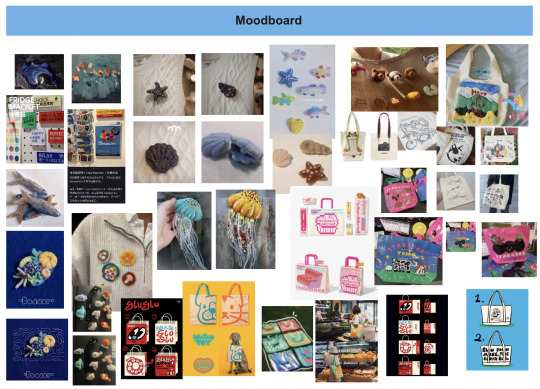

So What?
This predicament is because I was lazy and didn't draw more envisioned details such as fonts, colours, slogans, etc. I used Procreate to draw more details on my iPad and printed them on A4 paper. I think the advantages of this drawing app are that it covers a large number of drawing brushes, is easy to colour, dramatically reduces the time spent on using different tools in reality and is much faster and more convenient to use than Ai; the only disadvantage is that it doesn't have the same smoothness and realism as hand-drawn drawings. Additionally, I cropped the printout and used a Hook&Loop sticker to adhere it to the painted background, creating the feel of a removable refrigerator sticker and badge.
(Sketch + Paper Prototype)
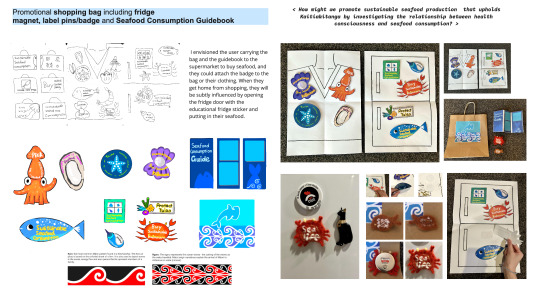
This experience reflects the importance of preparing in advance. Because I wanted to finish the paper prototype quickly, I was lazy and did not draw more detailed sketches, but the result that it took more time will also have a bad emotional impact on me.
Now What?
I realised that being well-prepared and implementing actions can often be twice as effective. In the next step of prototyping, I will make at least five sketches before I put them into action. At the same time, I will think of various forms of expression, try out different possibilities, and choose the most appropriate one after I have prepared at least three ways.
Reference
The University of Edinburgh. (2020, January 30). What? So what? Now what? The University of Edinburgh. https://www.ed.ac.uk/reflection/reflectors-toolkit/reflecting-on-experience/what-so-what-now-what
Borton. T. (1970). Reach Touch and Teach: Student Concerns and Process Education. McGraw-Hill, New York
Driscoll J. (1994). Reflective practice for practise. Senior Nurse, 13, 47-50
Rolfe, G., Freshwater, D., Jasper, M. (2001). Critical reflection in nursing and the helping professions: a user’s guide. Basingstoke: Palgrave Macmillan.
0 notes
Text
0 notes
Link
You have to use numerous models if you are pursuing or going to nursing courses. because in Nursing you must have to understand few most important theories like the Gibbs Reflective Cycle, Driscoll Model of Reflection, Clinical Reasoning Cycle, Elton Mayo’s Theory, and many more have vital importance in this field.
0 notes
Text
My mother tells me stories of living in New York and working in mirrored speakeasys that you could only find upon invitation. The outside was an antique shop, but the first door was hidden in a wardrobe. Instead of Narnia, it led to a nightclub, always packed as tightly as sardines with servers carrying their trays high above their heads, whistles screaming to let them through the crowd. Behind the bar, a second door sat unassuming and behind that there was a whole different world, dining rooms with windows towards the top like you were plants growing in a greenhouse, a pond with ducks swimming, a totem pole. Who would guess on the street that the unassuming antique shop was full of so many different worlds?
She tells me of, at the beginning of the AIDS epidemic, being in Harlem and learning how to take care of all the sick babies. And her boss kept saying your baby, your baby and how she asked if the babies were assigned per person and her boss chuckled and said that she would understand when she started. And how when she started, she knew that they were all of her babies and it made sense. She tells me about the two tiny twins with golden eyes unlike anything my mom had ever seen, a boy and a girl. She baked a birthday cake for a different little boy turning one, a big bird with yellow frosting feathers right off of sesame street. She told me about how if a baby was born with AIDS, when they hit a year sometimes they can slough off their mother’s immune system and get the chance to start a new life. The little boy with the big bird cake tested negative.
I was very brave, you know. She tells me. She rode the subway as the sun was leaking into the sky as daybreak hit. She tells me how Nancy Bounds saw her in a play, almost by accident, and told her she’d teach her how to model and take her to New York. I picture my mother at my age always being shy until she stepped under stage lights, but I wonder how it feels to see a chance and jump, even if you don’t have anyone to catch you at the bottom.
She tells me how the city is 13 miles long and five miles wide, about how everything is vertical and as tall as can be. You can’t ever look up, you have to just keep looking forward, you can never stop, you have to keep moving. It is strange to think that the New York my mother saw was before the twin towers fell and that she hadn’t seen it since. She points out all the bouroguhs, shows me a map. I laugh because Long Island really is a Long Island. Maybe someday I’ll see New York and think of how my steps mirror hers. My coworker tells me that I have her features and maybe I’ll be able to have her bravery too, her life experience, without cognac or warm beer to assist my journey. I wonder if I traveled back to the subway at daybreak in the early eighties if my mother would see my Driscoll nose, her eyes reflected in mine and see the similarities. It is so strange that my mother spent a decade somewhere that I know nothing about besides TV and movies. But the stories she tells me paint pictures that cinema never could.
1 note
·
View note
Text
The “Driscoll Reflective Model” is a framework which is associated with processes for reflection that helps in developing structural processes that are associated with reflection. Based on the several models of reflection it is appropriate from making the right choice since the reflection effectiveness depends on the individual using it. This model of reflection which has been mentioned in this part is associated with three types of stem questions that are “what”, “So what” and “Now what”
0 notes
Text
My method to learn poetry was contexted in Y Gaer in Brecon today, where the acclaimed anglo/welsh poet Gareth Writer-Davies gave a talk about his work. According to Y Gaer the poet was the Prole Laureate for 2017 and a Hawthornden Fellow in 2019. He has twice been shortlisted for the Bridport Poetry Prize and was highly commended in the Welsh Poetry Competition 2017. As well as two pamphlets from Indigo Dreams, he has published three collections with Arenig Press: The Lover's Pinch (2018), The End (2019) and Wysg, which he will be launching at this event.
https://en.powys.gov.uk/breconlibrary
I attended the event because Writer-Davies's latest book is relevant to the landscape of my inquiry both in narrative and terrain parameters. I questioned the artist at the event in order to learn about the form of poetry. I asked him about his use of free form to which he replied that he free forms within his natural structure. I interpreted this as an expert who works with the natural rhythm of his own mind. He continued to teach me to reflect:
"Say something, have something to say and then edit well."
I relate this to the Driscol model of reflection (2007) what, so what and what next, which I have used extensively as a positive framework and model of reflection from my collaborative dialogue inquiry and beyond.
I like this quote in his reading today,
"We have lived a long life,
We have to settle somewhere,
We have to have perspective." (Writer-Davies. 2022)
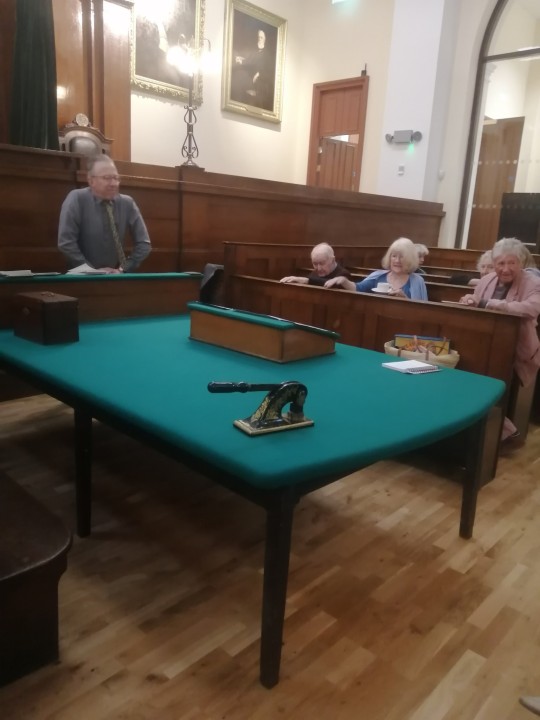




In contemplating the form in poetry, I learnt from Writer-Davies to start a successful poem with a couplet or keep the same syllables in each sentence. A couplet is two lines in a poem that follow one another and are joined by the rhythm and by the rhyme.
"Alexander Pope, a translator and poet, (1688) Pope primarily used the heroic couplet, and his lines are immensely quotable; from “An Essay on Criticism” come famous phrases such as “To err is human; to forgive, divine,” “A little learning is a dang’rous thing,” and “For fools rush in where angels fear to tread.”
0 notes
Text
Agile Project Management
MIS608_Assessment_2_Brief_Reflecton_Module Due 4.1 Page 1 of 9
Task Summary
“There are three things extremely hard: Steel, a diamond, and to know one’s self.”-
Benjamin Franklin
You are required to write and submit a 1500-word individual reflection about how your work as a
Agile Team is progressing so far. You are required to use Driscoll’s “What Model” (2007) as a
framework for this exercise and…
View On WordPress
0 notes
Text
Week 8
This week is still a prototype week for me. I have received a lot of helpful feedback from my peers and tutors about my paper prototype.
Things I have done this week:
1. Peer Review
2. Continue Prototyping/Drawing out the tracks for the pinball game
3. More prototypes based on the tutor and peers' feedback
Reflection/Thoughts on what I have done based on Rolfe et al's (2001) reflective model( What? So What? Now What?):
What?
Last week, I finished my paper prototype, and this week, I took it to school, where my tutor and classmates gave me helpful advice based on what I have done so far. One of my classmates told me that she thought my idea was very creative, and the pinball game was very playable and could be linked to my HMW statement well. Still, there was a lack of explanation, and it was hard for her to figure out the meaning of the icons next to each hole in the pinball game when she was playing it without any extra explanations from me, so she suggested that I should either make some cards or prepare some notes to be used for explaining the meaning of each icon to make my idea more straightforward. My tutor advised me to add some Māori elements to the card, such as Māori fishing traditions, ceremonies held before going to sea, honoring the sea, etc. These can be summarised and added in the form of a story on the back of the card to increase the connection between my prototype and the Māori community so that players can learn about how Māori support sustainable fish breeding in their traditional way through playing the pinball game, which will also be more relevant to my HMW statement as I mentioned "Tiakitanga", it needs me to focus on Māori form of protection of the sea, fish, ecological balance.
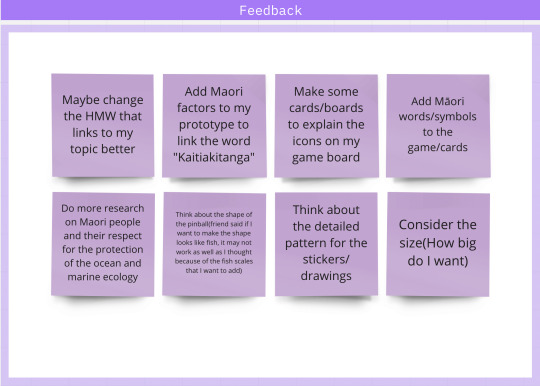
So What?
Based on the suggestions I've gathered, I continued the prototyping. I drew a more complete pinball track in Illustrator based on my previous paper prototyping and marked in detail the location of each hole and the icon stickers next to the holes, the location of the start and end points, the turntable, and the location of the slips on the turntable so that it will be more accessible for me to draw up a drawing for the laser cut to be made later.

I have also drawn some cards to explain the meaning of each sticker icon. I have currently decided to explain the icon on the front of the card and use the back to introduce Maori traditions of supporting sustainable fish breeding, the cards I have drawn so far are just rough drafts, I will use Illustrator to refine them further and print them out to make them easier to read for my target audience.
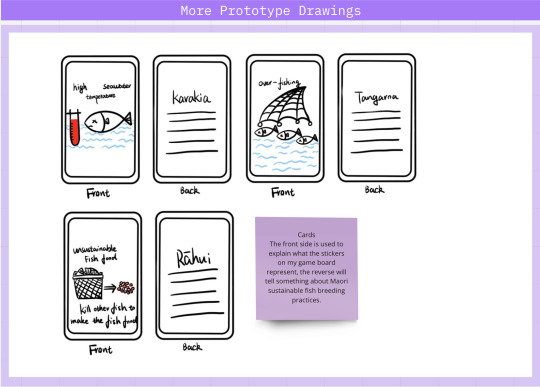
Now What?
Through making paper prototypes, I realized that when we designers design prototypes and solutions, we should not only focus on their appearance and playability but also on their practicality, which is far more critical than any other elements, and failing to let the target users feel the deep meaning of the product is a design failure. Although I've made a lot of progress so far, my final prototype is quite complex, and there's still much to do. And I can't afford to slack off in the next few days, I need to get a rough model of the prototype built as soon as possible and start working on the drawings for the laser cutting, the next week will be hectic.
Reference:
The University of Edinburgh. (2020, January 30). What? So what? Now what? The University of Edinburgh. https://www.ed.ac.uk/reflection/reflectors-toolkit/reflecting-on-experience/what-so-what-now-what
Driscoll, J. (1994) Reflective practice in practise. Senior Nurse 13 (7): 47–50.
Borton, T.(1970) Reach Touch and Teach: Student Concerns and Process Education.
Rolfe, G., Freshwater, D., Jasper, M. (2001) Critical reflection in nursing and the helping professions: a user's guide. Basingstoke: Palgrave Macmillan.
0 notes
Text
Agile Project Management
MIS608_Assessment_2_Brief_Reflecton_Module Due 4.1 Page 1 of 9
Task Summary
“There are three things extremely hard: Steel, a diamond, and to know one’s self.”-
Benjamin Franklin
You are required to write and submit a 1500-word individual reflection about how your work as a
Agile Team is progressing so far. You are required to use Driscoll’s “What Model” (2007) as a
framework for this exercise and…
View On WordPress
0 notes
Text
Agile Project Management
MIS608_Assessment_2_Brief_Reflecton_Module Due 4.1 Page 1 of 9
Task Summary
“There are three things extremely hard: Steel, a diamond, and to know one’s self.”-
Benjamin Franklin
You are required to write and submit a 1500-word individual reflection about how your work as a
Agile Team is progressing so far. You are required to use Driscoll’s “What Model” (2007) as a
framework for this exercise and…
View On WordPress
0 notes
Text
Driscoll's Model of Reflection For Nursing Students

Driscoll's Model of Reflection: Get Myassignmenthelp.co.uk expert or read the blog to understand the advantage of John, Rolfe & Borton’s model of reflection with examples.
https://bit.ly/3J6Q94R
0 notes